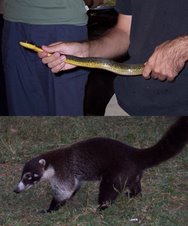Ch. 2 discussed random variables and probability distributions. I found this chapter really helpful. In the last several stats classes I've taken, we've discussed and/or used various types of probability distributions (Poisson, log-normal, etc.), but I've never really understood "what" they are/what they're based upon, nor in what cases they should be used. I've marked the pages with tables 2.3 and 2.4 - they have good, concise summaries of when and how to use each distribution.
On a side note, I really like the way these guys write. It's very accessible and easy to understand, unlike other stats texts I've read (e.g., Sokal and Ralph is a great example of an unreadable book!). They're pretty funny, too - I like the offhand comments like "In our continuing series of profiles of dead white men in wigs..." (p. 26). Keeps your attention.
The discussion of discrete vs. continuous variables reminded me of a paper I read for Phylogenetics class tonight, on the use of qualitative and quantitative variables in phylogenetic/cladistic analysis. Stevens (1991) argued that most traits used in cladistic analysis are quantitative/continuous, even some of those that were classed as discrete. Often, the classes/character states are determined arbitrarily by the analyst - and, no big surprise here, are defined in such a way as to fit their preconceptions of what the phylogenetic order should be. We like to think of science as objective, yet it's becoming more and more clear to me just how much our backgrounds and preconceptions influence our thinking, often without us even realizing (re: Journal Club today). Anyway, back to the topic of discrete variables - I think it's difficult to find discrete classes when measuring character states within a population, because there's so much individual variation. Even things seemingly quite discrete like color can vary - is that flower pale pink or white with a slight tinge? But when you're dealing with outcomes of trials, it is possible to have discrete variables - e.g., a coin toss can only be heads or tails (well, unless it lands on it's edge, which is extremely unlikely - but hey, when you're dealing with Ecology, it seems there's an exception for every rule). Interesting stuff...
Monday, January 29, 2007
Subscribe to:
Post Comments (Atom)




3 comments:
it looks like you have the honor of having attracted the first blog spam. i think you have the ability to selectively delete these. if they get too bad (frequent) i can show everyone a technique to cut down on them.
as to your post, it's interesting how different people have such different impressions of things. i actually rather like sokal and rohlf, although i realize i'm in the substantial minority here. it's probably a bias on my part, because jim rohlf helped me substantially on my dissertation analyses. conversely, i have noticed a fair number of places in G&E where i thought "that was needlessly complex" (e.g. that paragraph on p. 21 that i singled out in the wiki notes -- i had to reread that a half dozen times). on the whole, though i agree that G&E's informal tone goes a long way to making the subject less intimidating and more engaging.
Post a Comment